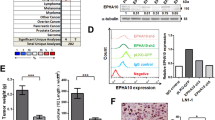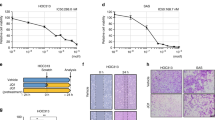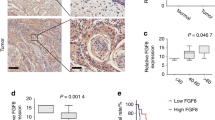Abstract
Podoplanin is highly expressed in human cancers. However, mechanisms regulating podoplanin expression remain elusive. Here we show that podoplanin promotes tumorigenesis of oral squamous cell carcinoma (OSCC) and precancerous cells both in vitro and in vivo, and the ErbB3-binding protein-1 (Ebp1) can be activated in oral tumorigenesis and can serve as a transcriptional activator to drive podoplanin expression in the malignant progression. Most of the OSCC cell lines have no detectable podoplanin protein in low-density cultures. However, the protein becomes detectable in high-density cultures and is required for in-vivo tumor formation of OSCC and oral premalignancies. In a high-density culture condition, podoplanin expression can be triggered at both mRNA and protein levels. In this condition, we showed that Ebp1 is upregulated, translocated from the cytoplasm to the nucleus and binds to the podoplanin promoter to result in a dramatic increase of podoplanin mRNA and protein. Ebp1 downregulation significantly reduced podoplanin expression levels in OSCC cells with a decreased anchorage-dependent growth, invasion and wound healing. Conversely, Ebp1 overexpression enhanced these malignant features through podoplanin upregulation both in vitro and in vivo. In 81 patients with oral premalignant lesions, we found that Ebp1 expression is strongly related to OSCC development. We conclude that Ebp1 has a key role in the upregulation of podoplanin and may contribute to oral tumorigenesis.
This is a preview of subscription content, access via your institution
Access options
Subscribe to this journal
Receive 50 print issues and online access
$259.00 per year
only $5.18 per issue
Buy this article
- Purchase on Springer Link
- Instant access to full article PDF
Prices may be subject to local taxes which are calculated during checkout







Similar content being viewed by others
References
Raica M, Cimpean AM, Ribatti D . The role of podoplanin in tumor progression and metastasis. Anticancer Res 2008; 28: 2997–3006.
Wicki A, Christofori G . The potential role of podoplanin in tumour invasion. Br J Cancer 2007; 96: 1–5.
Yuan P, Temam S, El-Naggar A, Zhou X, Liu DD, Lee JJ et al. Overexpression of podoplanin in oral cancer and its association with poor clinical outcome. Cancer 2006; 107: 563–569.
Kreppel M, Kreppel B, Drebber U, Wedemayer I, Rothamel D, Zöller JE et al. Podoplanin expression in oral leukoplakia: prognostic value and clinicopathological implications. Oral Dis 2012; 18: 692–699.
Mashhadiabbas F, Mahjour F, Mahjour SB, Fereidooni F, Hosseini FS . The immunohistochemical characterization of MMP-2, MMP-10, TIMP-1, TIMP-2, and podoplanin in oral squamous cell carcinoma. Oral Surg Oral Med Oral Pathol Oral Radiol 2012; 114: 240–250.
Shimamura Y, Abe T, Nakahira M, Yoda T, Murata S, Sugasawa M . Immunohistochemical analysis of oral dysplasia: diagnostic assessment by fascin and podoplanin expression. Acta Histochem Cytochem 2011; 44: 239–245.
De Sousa SF, Gleber-Netto FO, De Oliveira-Neto HH, Batista AC, Nogueira Guimarães Abreu MH, De Aguiar MC . Lymphangiogenesis and podoplanin expression in oral squamous cell carcinoma and the associated lymph nodes. Appl Immunohistochem Mol Morphol 2012; 20: 588–594.
Funayama A, Cheng J, Maruyama S, Yamazaki M, Kobayashi T, Syafriadi M et al. Enhanced expression of podoplanin in oral carcinomas in situ and squamous cell carcinomas. Pathobiology 2011; 78: 171–180.
Huber GF, Fritzsche FR, Züllig L, Storz M, Graf N, Haerle SK et al. Podoplanin expression correlates with sentinel lymph node metastasis in early squamous cell carcinomas of the oral cavity and oropharynx. Int J Cancer 2011; 129: 1404–1409.
Inoue H, Miyazaki Y, Kikuchi K, Yoshida N, Ide F, Ohmori Y et al. Podoplanin expression during dysplasia-carcinoma sequence in the oral cavity. Tumour Biol 2012; 33: 183–194.
Kawaguchi H, El-Naggar AK, Papadimitrakopoulou V, Ren H, Fan YH, Feng L et al. Podoplanin: a novel marker for oral cancer risk in patients with oral premalignancy. J Clin Oncol 2008; 26: 354–360.
Darnell JE Jr . Transcription factors as targets for cancer therapy. Nat Rev Cancer 2002; 2: 740–749.
Neph S, Stergachis AB, Reynolds A, Sandstrom R, Borenstein E, Stamatoyannopoulos JA . Circuitry and dynamics of human transcription factor regulatory networks. Cell 2012; 150: 1274–1286.
Kim CK, Nguyen TL, Joo KM, Nam DH, Park J, Lee KH et al. Negative regulation of p53 by the long isoform of ErbB3 binding protein Ebp1 in brain tumors. Cancer Res 2010; 70: 9730–9974.
Hamburger AW . The role of ErbB3 and its binding partners in breast cancer progression and resistance to hormone and tyrosine kinase directed therapies. J Mammary Gland Biol Neoplasia 2008; 13: 225–23.
Lessor TJ, Yoo JY, Xia X, Woodford N, Hamburger AW . Ectopic expression of the ErbB-3 binding protein ebp1 inhibits growth and induces differentiation of human breast cancer cell lines. J Cell Physiol 2000; 183: 321–329.
Zhang Y, Akinmade D, Hamburger AW . The ErbB3 binding protein Ebp1 interacts with Sin3A to repress E2F1 and AR-mediated transcription. Nucleic Acids Res 2005; 33: 6024–6033.
Zhang Y, Ali TZ, Zhou H, D'Souza DR, Lu Y, Jaffe J et al. ErbB3 binding protein 1 represses metastasis-promoting gene anterior gradient protein 2 in prostate cancer. Cancer Res 2010; 70: 240–248.
Scholl FG, Gamallo C, Quintanilla M . Ectopic expression of PA2.26 antigen in epidermal keratinocytes leads to destabilization of adherens junctions and malignant progression. Lab Invest 2000; 80: 1749–1759.
Wicki A, Lehembre F, Wick N, Hantusch B, Kerjaschki D, Christofori G . Tumor invasion in the absence of epithelial-mesenchymal transition: podoplanin-mediated remodeling of the actin cytoskeleton. Cancer Cell 2006; 9: 261–272.
Cortez MA, Nicoloso MS, Shimizu M, Rossi S, Gopisetty G, Molina JR et al. miR-29b and miR-125a regulate podoplanin and suppress invasion in glioblastoma. Genes Chromosomes Cancer 2010; 49: 981–990.
Hwang YS, Xianglan Z, Park KK, Chung WY . Functional invadopodia formation through stabilization of the PDPN transcript by IMP-3 and cancer-stromal crosstalk for PDPN expression. Carcinogenesis 2012; 33: 2135–2146.
Hantusch B, Kalt R, Krieger S, Puri C, Kerjaschki D . Sp1/Sp3 and DNA-methylation contribute to basal transcriptional activation of human podoplanin in MG63 versus Saos-2 osteoblastic cells. BMC Mol Biol 2007; 8: 20.
Tammela T, Alitalo K . Lymphangiogenesis: molecular mechanisms and future promise. Cell 2010; 140: 460–476.
Martín-Villar E, Yurrita MM, Fernández-Muñoz B, Quintanilla M, Renart J . Regulation of podoplanin/PA2.26 antigen expression in tumour cells. Involvement of calpain-mediated proteolysis. Int J Biochem Cell Biol 2009; 41: 1421–1429.
Zhou X, Chen W, Zhang Y, Sun J, Wang Q, Yu Y . Potential therapeutic strategy for oral squamous cell carcinoma by ErbB3-binding protein 1 gene transfer. J Cancer Res Clin Oncol 2010; 136: 891–896.
Peterziel H, Müller J, Danner A, Barbus S, Liu HK, Radlwimmer B et al. Expression of podoplanin in human astrocytic brain tumors is controlled by the PI3K-AKT-AP-1 signaling pathway and promoter methylation. Neuro Oncol 2012; 14: 426–439.
Honma M, Minami-Hori M, Takahashi H, Iizuka H . Podoplanin expression in wound and hyperproliferative psoriatic epidermis: regulation by TGF-beta and STAT-3 activating cytokines, IFN-gamma, IL-6, and IL-22. J Dermatol Sci 2012; 65: 134–140.
Shen Y, Chen CS, Ichikawa H, Goldberg GS . SRC induces podoplanin expression to promote cell migration. J Biol Chem 2010; 285: 9649–9656.
Kunita A, Kashima TG, Ohazama A, Grigoriadis AE, Fukayama M . Podoplanin is regulated by AP-1 and promotes platelet aggregation and cell migration in osteosarcoma. Am J Pathol 2011; 179: 1041–1049.
Ohta M, Abe A, Ohno F, Hasegawa Y, Tanaka H, Maseki S et al. Positive and negative regulation of podoplanin expression by TGF-beta and histone deacetylase inhibitors in oral and pharyngeal squamous cell carcinoma cell lines. Oral Oncol 2012; 49: 20–26.
Monie TP, Perrin AJ, Birtley JR, Sweeney TR, Karakasiliotis I, Chaudhry Y et al. Structural insights into the transcriptional and translational roles of Ebp1. EMBO J 2007; 26: 3936–3944.
Mei YP, Liao JP, Shen J, Yu L, Liu BL, Liu L et al. Small nucleolar RNA 42 acts as an oncogene in lung tumorigenesis. Oncogene 2012; 31: 2794–2804.
Mei Y, Yuan Z, Song B, Li D, Ma C, Hu C et al. Activating transcription factor 3 up-regulated by c-Jun NH(2)-terminal kinase/c-Jun contributes to apoptosis induced by potassium deprivation in cerebellar granule neurons. Neuroscience 2008; 151: 771–779.
Acknowledgements
We thank Dr AW Hamburger for providing Ebp1 and control vectors, and Dr B Hantusch for providing the podoplanin promoter vectors.
Author information
Authors and Affiliations
Corresponding author
Ethics declarations
Competing interests
The authors declare no conflict of interest.
Additional information
Author Contributions
LM provided conceptual framework. LM and YM designed experiments. YM, PZ, HZ, RX and DC performed the experiments. RX and JL provisioned clinical samples and data. ZL performed statistical analysis. All authors discussed the results and participated in the manuscript writing.
Supplementary Information accompanies this paper on the Oncogene website
Supplementary information
Rights and permissions
About this article
Cite this article
Mei, Y., Zhang, P., Zuo, H. et al. Ebp1 activates podoplanin expression and contributes to oral tumorigenesis. Oncogene 33, 3839–3850 (2014). https://doi.org/10.1038/onc.2013.354
Received:
Revised:
Accepted:
Published:
Issue Date:
DOI: https://doi.org/10.1038/onc.2013.354
Keywords
This article is cited by
-
ERBB3 binding protein 1 promotes the progression of malignant melanoma through activation of the Wnt/ β-catenin signaling pathway
Cancer Cell International (2022)
-
PA2G4 promotes the metastasis of hepatocellular carcinoma by stabilizing FYN mRNA in a YTHDF2-dependent manner
Cell & Bioscience (2022)
-
The roles of multifunctional protein ErbB3 binding protein 1 (EBP1) isoforms from development to disease
Experimental & Molecular Medicine (2020)
-
Podoplanin enhances lung cancer cell growth in vivo by inducing platelet aggregation
Scientific Reports (2017)



